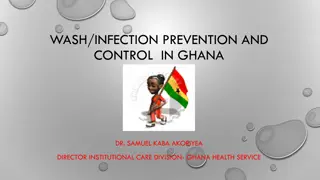Community-Based Health Planning and Services (CHPS) in Ghana: A Key Strategy for Healthcare Expansion
The Community-Based Health Planning and Services (CHPS) arrangement is crucial for enhancing healthcare provision in Ghana. This strategy involves mobilizing community leadership, resources, and frontline health staff to deliver essential services based on the principles of primary healthcare. Since its initiation in 1994, CHPS has aimed to address barriers to healthcare access, with notable success in reducing infant mortality rates. Despite challenges, CHPS remains a vital component of Ghana's healthcare system.
Download Presentation

Please find below an Image/Link to download the presentation.
The content on the website is provided AS IS for your information and personal use only. It may not be sold, licensed, or shared on other websites without obtaining consent from the author. Download presentation by click this link. If you encounter any issues during the download, it is possible that the publisher has removed the file from their server.
E N D
Presentation Transcript
THE COMMUNITY-BASED HEALTH PLANNING AND SERVICES (CHPS) ARRANGEMENT REMAINS THE KEY STRATEGY FOR EXPANDING HEALTH SERVICES PROVISION IN GHANA. DISCUSS By Akua Boatemaa Gambrah-Sampaney 1
OUTLINE PRIMARY HEALTH CARE AND CHPS WHAT CPS IS HISTORY OF CHPS OBJECTIVES AND KEY ELEMENTS OF CHPS COMPONENTS OF CHPS PROCESS 15 STEPS AND MILESTONE FOR CHPS IMPLEMENTATION CHALLENGES OF CHPS ADVANTAGES OF CHPS CONCLUDING STATEMENT REFERENCES 2
PRIMARY HEALTH CARE (PHC) & CHPS Public health care is an essential health care which is ground on socially acceptable and scientifically sound methods that are universally accessible to individuals and families with their full participation at costs that countries and communities can afford in the spirit of self determination and self reliance. Ghana re-launched the CHPS policy to elevate PHC as a priority on the national agenda to continue to strengthen and scale the CHPS model to parts of the country that are not yet covered. 3
WHAT IS CHPS? Community-based Health Planning and Services (CHPS) is defined as the mobilization of community leadership, decision making systems and resources in a defined catchment area (zone), the placement of reoriented frontline health staff (CHO), with logistic support and community volunteer systems to provide services according to the principles of primary health care (PHC). It is a national strategy that is aimed at delivering essential community-based health services involving health planning and service delivery within the communities. 4
HISTORY OF CHPS The CHPS initiative was created in 1994 in Ghana with the aim of reducing barriers to geographical access to healthcare. The Ghana Health Service, through the Ministry of Health, pioneered the implementation of CHPS, which began as a Community Health and Family Planning (CHFP) project in Ghana, based on lessons learned from Bangladesh (Phillips, 1988) as a close-to-client doorstep health delivery with household and community involvement. Approved for implemention in 1999 after a preliminary success with an experimental trial in Navrongo in the Upper East region in 1990 in order to replicate the results of the Navrongo Community Health Family Planning in the Kassena-Nakana district which saw a drastic reduction in infant mortality rate. Some key pilot districts at the introduction of the CHPS were: the Nkwanta South in the Volta region, Birim-North in the Eastern region and the Abura-Asebu-Kwamankese in the Central region. 6
HISTORY CONTINUED CHPS is made of 6 principles namely: Community participation, empowerment, ownership, gender considerations and volunteerism CHPS is composed of ; CHPS zone: which is a demarcated geographical area where activities would be carried CHPS compound- an approved structure consisting of a service delivery point and accommodation complex Community health officer (CHO): a trained and oriented health personnel who mostly acts as the leader and community mobilizer and Community Health Volunteers (CHVs), non-salaried community members identified and trained persons supporting CHOs in a community within the CHPS zone 7
OBJECTIVES AND KEY ELEMENTS OBJECTIVES OF CHPS: To improve equity in access to basic health services To improve efficiency and responsiveness to client needs To improve inter-sectoral collaboration and partnership in service delivery The KEY ELEMENTS OF CHPS INCLUDE : The community as a social capital, households and individuals as the targets, community participation and community centered service delivery. 8
15 STEPS AND MILESTONE FOR CHPS IMPLEMENTATION 1.Plan 2.Consult and raise awareness of CHPS 3.Dialogue with community leadership 4.Community Information Durbar 5.Select and train CHOs 6.Select, approve and orient Community Health Management Committee (CHMC) 7.Compile Community Profile 8.Compound Construction / Operationalize Compound 10
MILESTONES CONTINUED 9. Provide CHPS Logistics 10.Durbar to launch activities of the CHPS zone 11. Select Community Health Volunteers (CHVS) 12. Approve CHV Selection 13. Train CHVs 14. Procure Logistics, Equipment and Volunteers supplies 15. Launch the CHPS zone 11
CHALLENGES OF CHPS HEALTH WORKER-BASED CHALLENGES: Health professionals' negative attitudes, high attrition rates among CHOs/Community Health Nurses (CHNs), and insufficiency and/or unavailability of CHOS/CHNs at post when needed COMMUNITY BASED CHALLENGES: Community members' lack of ownership of the CHPS program, lack of security at CHPS compounds, and late reporting of cases HEALTH SYSTEM-BASED CHALLENGES: Late referrals, limited funding/lack of resources, lack of proper community access and participation, non- availability of key logistics for running CHPS, distance of CHPS Compounds from communities 12
ADVANTAGES OF CHPS The introduction of the CHPS is seen as a way of making health care equitable, accessible, and affordable to the poor in society. With CHPS in every sub-district, people will be able to access health care facilities freely without fear of distance and hindrance which will in turn reduce mortality. As the smallest health unit, CHPS puts health in close proximity to clients who are resource constrained and helps them access health care. It offers an option to integrate health interventions with other social and developmental agenda focusing on health promotion and prevention. Serves as a port of entry to a health system connecting clients through referral to secondary and tertiary care in a more targeted or assertive manner which is an improvement of access. Community ownership and participation in health is best achieved at the CHPS level where people are more connected than in bigger facilities. 13
CONCLUDING STATEMENT In conclusion, the CHPS is a way of making health care equitable, accessible, and affordable to the poor in society. While there have been "ups and downs" in the implementation of this policy, there is hope that it will gain a strong foundation one day. It has benefited communities by bringing healthcare to the doorsteps of its members, resulting in a significant reduction in mortality and morbidity rates. In villages without CHPS compounds, getting health care has been challenging since residents must travel to other settlements or larger towns. Every individual, particularly the government, must contribute to the enhancement of the CHPS' services in this way. 14
REFERENCES The Concept Of Community-Based Health Planning And Service (chps) In Ghana. (n.d.). Retrieved May 15, 2022, from https://www.modernghana.com/news/930714/the-concept-of- community-based-health-planning.html Translating research into practice to ensure community engagement for successful primary health care service delivery: The case of CHPS in Ghana | PHCPI. (n.d.). Retrieved May 15, 2022, from https://improvingphc.org/translating-research-practice-ensure-community- engagement-successful-primary-health-care-service-delivery-case-chps-ghana Summary of 15 steps and milestones for CHPS implementation | PHCPI. (n.d.). Retrieved May 15, 2022, from https://improvingphc.org/summary-15-steps-and-milestones-chps- implementation 15
REFERENCES Components of the CHPS process | Download Scientific Diagram. (n.d.). Retrieved May 15, 2022, from https://www.researchgate.net/figure/Components-of-the-CHPS- process_fig1_8043942 Johnson, F. A., Frempong-Ainguah, F., Matthews, Z., Harfoot, A. J. P., Nyarko, P., Baschieri, A., Gething, P. W., Falkingham, J., & Atkinson, P. M. (2015). Evaluating the Impact of the Community-Based Health Planning and Services Initiative on Uptake of Skilled Birth Care in Ghana. PLOS ONE, 10(3), e0120556. https://doi.org/10.1371/JOURNAL.PONE.0120556 Spread the benefits of CHPS measures Dr Amo-Mensah. (n.d.). Retrieved May 15, 2022, from https://www.ghanaweb.com/GhanaHomePage/NewsArchive/Spread-the-benefits-of- CHPS-measures-Dr-Amo-Mensah-300865 16
THANK YOU!!!! I am open to your questions now. 17























